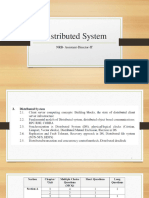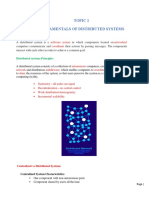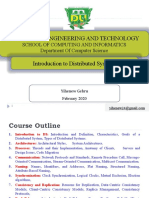0 ratings0% found this document useful (0 votes) 97 views88 pagesDistributed Quantum Organized
Copyright
© © All Rights Reserved
We take content rights seriously. If you suspect this is your content,
claim it here.
Available Formats
Download as PDF or read online on Scribd
a CONTENTS el
KCS 077 : Distributed Systems
UNTT:1: CHARACTERIZATION OF DISTRIBUTED SYSTEM (1-1 Bto 1-22 B)
Introduction, Examples of distributed Systems, Resource sharing and the
Web Challenges. Architectural models, Fundamental Models.
Theoretical Foundation for Distted Syste Limitation of Distributed
system, absence of global clock, shared memory, ;
ectoe local locks, ed memory, Lagi clociaLamport's
Concepts in Message Passing Systems: Causal order, total order, total
causal order, Techniques for Message Ordering, Causal ordering of
messages, global state, termination detection.
UNIT-2:: DISTRIBUTED MUTUAL EXCLUSION (2-1 Bto 2-18 B)
Distributed Mutual Exclusion: Classification of distributed mutual
exclusion, requirement of mutual exclusion theorem, Token based and
rnon token based algorithms, performance metric for distributed mutual
exclusion algorithms.
Distributed Deadlock Detection: system model, resource Vs communication
deadlocks, deadlock prevention, avoidance, detection & resolution,
‘centralized dead lock detection, distributed dead lock detection, path pushing
+ algorithms, edge chasing algorithms.
AGREEMENT PROTOCOLS (8-1 Bto3-32B)
“Agreement Protocols: Introduction, System models, classification of
/‘ngreement Problem, Byzantine agreement problem, Consensus problem,
Interactive consistency Problem, Solution to Byzantine Agreement
problem, Application of Agreement problem, Atomic Commit in
Distributed Database system.
Distributed Resource Management: Issues in distributed File Systems,
Mechanism for building distributed file systems, Design issues in
Diatributed Shared Memory, Algorithm for Implementation of Distributed
Shared Memory.
FAILURE RECOVERY IN DS (4-1 B to 4-21 B)
‘ilure Recovery in Distributed Systems: Concepts in Backward and
Forward recovery, Recovery in Concurrent systems, Obtaining consistent
Checkpoints, Recovery in Distributed Database Systems. Fault Toleranet:
Cases Fault Tolerance, Commit Protocols, Voting protocols, Dynamic
voting protocols.
TRANSACTIONS CONTROL (5-1 B to 5-32 B)
Y snsactions and Concurrency Control: Transactions, Nested transactions,
Locks, OptimisticConcurrency control, Timestamp ordering, Comparison
of methods for concurrency control.
Diueibuted Transactions: Flat and nested distributed transactions, Atomic
Commit protocols, Concurrency control in distributed transactions,
Distributed deadlocks, Transaction recovery:
Replication: System model and group communication, Fault - tolerant
services, highly available services, Transactions with replicated data
SHORT QUESTIONS (SQ-1 B to SQ-17 B)
SOLVED PAPERS (2014-15 TO 2020-21) (SP-1 B to SP-23 B)
Scanned with CamScanner�Characterization of Dintributed System
1-2 (C8-8em-7)
PAR’
Introduction, Example of Distributed System.
Characterization of
Distributed System
Long Answer Type and Medium Answer Type Questions
distributed system ? Describe the main
Que td. | What it
characteristics of distributed system. Give two example of
siecle
Answer
Distributed eystem :
1. A distributed system is @ system in which software or hardware
‘components connected va communication netwack communicates and”
CONTENTS
Part-1: Introduction, Example
of Distributed System
14B to 1-98
Resource Sharing and Web
Part? =
Ghatenges, Architectural
Sede Fundamental Models
ordinates their actions only by pasting me
«_Theoretial Foundation fof nwo A108 (0 1-188 ther ati —
Parts Mart yen : Linialons 2 Computers that are connected bya network may be spatially
idistance, separated
4. Resources may be managed by serves and secesed byeients.
of Distributed System,
Absence of Global Clock,
Shared Memory
vw 1-12B to 1-18B
Characteristics of distributed system :
11. Heterogeneity : Distributed system enables the users to access services
and run application over a heterogeneous collection of computers and
Part-4 + Logical Cock, Lamport
and Vectors Logieal Clocks ae
v~ 1H16B to 1-208 2 Openness : The openness ofa computer system isthe characteristics
that determine whether the system canbe extended and reimplemented
Part-5 : Concept in Message System
Causal Order, Total Order, Total
Ceusal Order, Techniques for
Message Ordering, Causal
Ordering of Messages,
Ghbal State and Termination Detection.
in various ways
“8 Concurrency : Concurrency in distributed system is use to help diferent
users to access the shared resource atthe same time.
A system is described as scalable if it remains effective
xis significant increase inthe number of resources and the
numbers of users.
© Security : Security provides confidentially, integrity and availability of
the information resources.
Example of distributed system:
1. Internet : The Internet isa very large distributed system. Itenables
users to make use of services such as the World Wide Web, e-mail and
1-1B(C8-Sem-7) file transfer.
‘Scanned with CamScanner�Distributed System ISB CS Seme7) TF _40 (C8-8em-7) Characterization of Distributed
of item
2 Intranet : 3 4. Incremental grovth Computing power can -
a An intranet is a private network that is contained within aq increments, a
ees . & Data sharing: Allow many users access to a common d
; ' atabase.
1k Anintrane is connected to the internet vi router, which allows J gq Doviee sharing: Allow many users toshareener noe
‘he users inside the intranet to make use of services such as web op Flexibility : In distri : oan
1 in distributed computing workload can be spread over
c the available machines inthe most cost effective way,
Quer | What are distributed systems ? What are significant Gara] ae ved _ ‘nea
advantages and applications of distributed system ? . tributed transparency ? Explain the different
ARTU 2018-19, Marke] types of distributed transparencies.
‘Answer
Answer i
4 Distributed transparency is the property of distributed databases
Distributed system : Refer Q. 1.1, Page 1-2B, Unit-1. tirtu of which the internal details of the distribution are biddes othe
Advantages of distributed system : users.
1. Data sharing :It allows many users to access to acommon database, |] TYP¢s of transparencies :
: cae i i |. Access transparency : It enables local and remote resources to be
2 Resource sharing : Expensive peripherals like color printers canbe [J 1 ans) 7
shared among different nodes (or systems). 7 ae re iteniieal _— i
pate ae nl Location transparency It enables resources tobe accessed without
S Communication : Enhance human-to-human communication, eg, knowledge oftheir physical or network location.
email. chat.
‘4 Flexibility : Spread the workload over the available machines, Se ae dared canna euaet iicascne ites
Applications of distributed systems: them.
1 Telecommunication networks such as telephone networks and cellular J) 4 Replication transparency :It enables multiple instances of resources
tobe used to increase rebaility and performance withost knowledge of
networks,
2 _ Network applications, worldwide web and peer-to-peer networks. the replica by users op
3. Real-time process controls airraft control systems Failure transparency :It enables the concealment of fults allowing
4 ee users and application program to complete their tasks despite the failure
ofhardwvare or software components
SETS] How the distributed computing system is better than |) 6 Performance transparency Itallowsthe system tobe reconfigured
toimproved performances as load varies.
parallel procesing tem? Eephin, [RETURNED] fe oom
Distributed computing system is better than parallel processing system
because of following advantages pel "
1. Economics : Microprocessors offer better performance than parallel
processing system.
2 Speed :A distributed system may have more total computing power
than parallel processing system. .
‘& Reliability : If some of the machines are downed, the distributed
system as a whole can still survive with small degradation of
performance.
Scanned with CamScanner�i araen ee aes
Distrib
a ——
jadone in distributed tystem
GQuets. | How the resource sharing
Explain with an example.
al
L FReanurce sharing is one of the mor"
Each resource must be managed by & Eee ato}
in re rea
. eeu
=
—- one
vente mine
Rae ler
ere saree ein
sees ad
a ‘The serverexecutes the request and sends back a reply tothe client
rect deaeseaee
Ques. | Discuss the major issue in designing a
system.
‘Answer
‘Major issues in designing a distributed system :
1. Heterogeneity:
‘a. Distributed system must be constructed from variety of different
networks, operating systems, computer hardware’s and
programming languages.
b. Internet communication protocol mask the difference
heterogeneity) in networks and middleware can deal with the
other differences.
Openness: Distributed system should be extensible ie. to develop
interface forthe distributed system component so that they ean be
integrated to new extension of distributed system.
A Security:
a. Encryption can be used to provide adequate amount of shared
resources and to keep sensitive information secret when itis
transmitted in messages over a network.
Denial of Services DoS) attacks one ofthe big problems for security.
cdvantages which is obtained
.sare enclosed within comy
by communicat
a
4. Sealaiity
Scalability refern tothe capability of a system to adapt to
sreased service load. "
1 Ininovtbe that dite system il ero thine ict
tn very common to add new machines to ake cre of creased
stork lad Therefre, a itibted rate shoal be designed to
aly cope with the growth of nodes and users inthe system
5 Fault avoidance:
Fault avoidance dese wth desing the component ofthe tem
ineucha may thatthe occurrence af ft sunimie
Conservative design practice auch a8 using high reliability
commponent are eten employed for improving the ayer’
Felbltybasedonthe eaof fal avedance
Transparency +
a Transparency sins to hide the details fist fom the ere
bh Foran example, wero programmer need not be concerned with
Heloaton rte details eho ts operations ace accessedby oer
ompancnts or whether it wile repitedormirated
Jie 177] Why is scalability an important feature inthe design of
distributed system ? Discuss some of the guiding principles for
‘designing a scalable distributed system.
‘ane
Scalability is important
because:
Ithelps the system to work efficiently
users.
bh. Trinereases the system performance by incorporating additions)
resources.
Guiding principle for designing scalable distributed system:
1. Avoid centralized entities:
‘a. Use ofcentralized entities shouldbe avoided inthe design of sealable
distributed system because
teoentralied system, ifeentralized entity fas then the entire
system will also foil
Capocity ofthe network that connets the centralized entity
gets saturated.
In case of wide-area network system,
increases.
TARTU 2014-15, Marks 10)
features in design of distributed system
a swith an increase in number of
traffic in the network
Scanned with CamScanner

























































